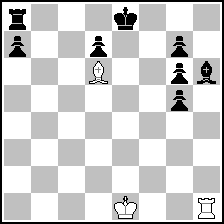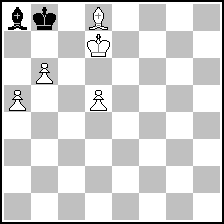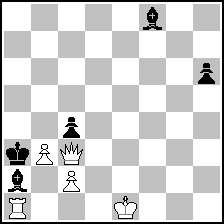
Website founded by
Milan Velimirović
in 2006
0:36 UTC


| |
MatPlus.Net  Forum Forum  Promenade Promenade  If uncastling were allowed in chess If uncastling were allowed in chess |
| |
|
|
|
|
You can only view this page!
| | | (1) Posted by James Malcom [Thursday, Jun 18, 2020 06:14]; edited by James Malcom [20-06-18] | If uncastling were allowed in chess
A silly question-what if uncastling were allowed in chess?
Of course, thousands of problems would be ruined, so let's pretend we have a fresh seperate world to do this in. I would say that, logically, all retro conventions that apply to castling would also apply to uncastling. You can only uncastle if the king and rook have not moved from their castling positions, making it paradoxically unreversible and reversible. Of course I will have just set up a few snags, but those should be easily fixable if found.
Here is an example position that I've built.
White To Move And Draw
 (= 3+8 ) (= 3+8 )
It seems like their is an easy mate mate in 3-1.0-0 0-0-0 2.Rb1 ~ 3. Rb8#. But remember, Black is allowed to uncastle! 2... retracts 0-0-0 is the only defense agaisnt Rb8#. Now all White can do is threaten mate in one again with 3. Rf1, and again Black can only defend with castling-White draws by threefold repetition. I made the key themetic just for fun.
In other words: 1. 0-0! 0-0-0 2. Rb1 retracts 0-0-0 3. Rf1 0-0-0 4. Rb1 retracts 0-0-0 5. Rf1 retracts 0-0-0 6. Rb1 retracts 0-0-0 and now White announces to the arbiter their intention to play 7. Rf1 and claims a draw.
Threefold repetition gets a bit more complex, with two different castling rights now having to be accounted for. Claiming draw for the position with on Rf1, to play Rb1, takes longer since it involves since in the uncastling position. That means that the position has to repeated four times, not three-one for the position after the first move in which there are uncastling rights and three for after 2. Rb1 when they are gone. The position with the Rb1 is faster since no uncastling rights are involved, which greatly helps if White is in time trouble.
Feel free to come up with your own examples and discuss. This chess variant has a simple and obvious name-"Uncastling Chess."
Also, does anyone have good ideas for what the notations for uncastling should be? IMO, an arrow beside each castling would do-<0-0 and >0-0-0. The arrows symbolically go the opposite way their respective castlings.
| | | (2) Posted by Hauke Reddmann [Thursday, Jun 18, 2020 11:18] |
Is uncastling uncastling (i.e. after that you can castle
again, "it never happened"), or a separate move? I would
tend to the second interpretation, in which case Black
would be boinked when he tries OOO a second time - after
all K and R already moved in this game ;-)
| | | (3) Posted by Jakob Leck [Thursday, Jun 18, 2020 12:57] |
Funny idea.
My suggestion for the notation would be -0-0 and -0-0-0 for the reverse castling.
What about uncastling rights in this chess variant? Do we stipulate - in analogy to regular castling rights - that uncastling is only allowed if the rook and king have arrived at d8 and c8 or f8 and g8 etc. via castling and not moved since?
Hauke's remark is a good point and I agree with his interpretation that after 1.0-0 0-0-0 2.Rb1 -0-0-0 3.Rf1 black can no longer castle. (The other interpretation of the rules would - in principle, no idea how to construct this - allow some sort of castling ping-pong with one side playing 0-0, -0-0, 0-0-0, -0-0-0 etc. in sequence :) )
Also, this touches on only one of the irreversible aspects of chess, the others being pawn moves (including promotion) and captures (leaving aside game-ending events like checkmate). So what about "reversible chess"? I.e., in addition to the regular rules, retractions of moves are allowed to be played as forward moves.
Some sensible limitations on this would be the uncastling rights suggested above and the restriction that only pieces that have already been captured can be uncaptured. A backward en passant capture played forward would have to force the opposing player to play P_5-_7.
| | | (4) Posted by Sarah Hornecker [Thursday, Jun 18, 2020 13:38]; edited by Sarah Hornecker [20-06-18] |
This probably dualististic schema offers further questions.
 (= 5+2 ) (= 5+2 )
Reversible Chess
h=1, h=1.5, h=2
h=1: 1. -Kb7:Sb8 Bd8-c7= (or -Bc7-d8=)
h=1.5: 1.- -c:b6 e.p. 2. -b7-b5 Bd8-b6= (or -Bb6-d8=)
h=2: 1. -Bb7:Sa8 Sa8-c7 (or -Sc7-a8) 2. -Ba6xBb7 Bb7xBa6=
In the solution Black uncaptures a White bishop, but the White bishop then captures the Black bishop.
| | | (5) Posted by James Malcom [Thursday, Jun 18, 2020 15:54]; edited by James Malcom [20-06-18] |
QUOTE
that uncastling is only allowed if the rook and king have arrived at d8 and c8 or f8 and g8 etc. via castling and not moved since?
That is correct Jakob. And in regards to castling rights, I suppose the idea is that each uncastling "resets" the castling rights, and that each castling resets uncastling rights, allowing for an ad infitnum. Such a "castling ping-pong" that you speak of is exactly shown in my "study" above, in which White draws via threefold repetition by forcing Black to repeatedly castle and uncastle. To me it's neater instead of allowing it just once.
And while there are indeed other irreverible moves in chess, I figured castling would be the easiest and strangest to explore. But Reversible Chess is just as fun as Siegfried shows.
| | | (6) Posted by Sarah Hornecker [Monday, Jun 29, 2020 01:39]; edited by Sarah Hornecker [20-06-29] |
I got Werner Keym's new book "Anything But Average". It contains this problem as no.338:
Valery Dubrovsky
Redkie shanry plyus 1996
 (= 5+5 ) (= 5+5 )
Mate in 2
Retro castling
1.0-0-0 Bb4 2.Qb2 mate, or 1.-B:b3 2.0-0-0 mate (Kc1-e1; Rd1-a1)
So apparently uncastling was already invented by Dubrovsky in 1996 under the name "Retro castling". Are there earlier examples (also, I found only one other mention of this source on the internet, on a 1st prize problem on Christian Poisson's website, quoting the "Russian Album" 1995-1997. Can someone provide information on this? http://christian.poisson.free.fr/problemesis2000/albumrussia9597.html)
| | | (7) Posted by Andrew Buchanan [Monday, Jun 29, 2020 02:57]; edited by Andrew Buchanan [20-06-29] |
Thanks Siegfried - honestly I think Rewan’s example are the beginning of the thread is better thematically than this one.
All I can contribute is a notation. I suggest -0- and -0-0-.
| | | (8) Posted by Guus Rol [Sunday, Dec 13, 2020 17:59] |
Digging up an old thread because it related to something I looked at long ago. When I invented my notation system I wrote the uncastling move as 0+0 or 0+0+0. Obviously retracting 0+0+0 effectively castles!
Note this rule provides a nice way to produce a Kofman-like problem without retraction phase. Uncastling forward proves that white has castled earlier in the game (by Rewan Demontay's rule). When the prior white castling right is mutually exclusive with a black castling right you just proved that black has no longer castling right!
| |
No more posts |
MatPlus.Net  Forum Forum  Promenade Promenade  If uncastling were allowed in chess If uncastling were allowed in chess |
|
|
|
 ISC 2024
ISC 2024 Forum
Forum  Promenade
Promenade  If uncastling were allowed in chess
If uncastling were allowed in chess 


